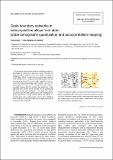Grain boundary networks in nanocrystalline alloys from atom probe tomography quantization and autocorrelation mapping
Author(s)
Chen, Ying; Schuh, Christopher A.
DownloadPhysica-Chen-Schuh-APT-2015-6-16.pdf (2.939Mb)
OPEN_ACCESS_POLICY
Open Access Policy
Creative Commons Attribution-Noncommercial-Share Alike
Terms of use
Metadata
Show full item recordAbstract
A local spatial autocorrelation-based modeling method is developed to reconstruct nanoscale grain structures in nanocrystalline materials from atom probe tomography (APT) data, which provide atomic positions and species, with minimal noise. Using a nanocrystalline alloy with an average grain size of 16 nm as a model material, we reconstruct the three-dimensional grain boundary network by carrying out two series of APT data quantization using ellipsoidal binning, the first probing the anisotropy in the apparent local atomic density and the second quantifying the local spatial autocorrelation. This approach enables automatic and efficient quantification and visualization of grain structure in a large volume and at the finest nanoscale grain sizes, and provides a means for correlating local chemistry with grain boundaries or triple junctions in nanocrystalline materials. Nanoscale grain boundary networks are reconstructed from atom probe tomography data, which provide atomic positions and species for a fraction of atoms within a nanocrystalline material with an average grain size of 16 nm, using a quantization and local spatial autocorrelation-based approach.
Date issued
2015-07Department
Massachusetts Institute of Technology. Department of Materials Science and EngineeringJournal
physica status solidi (a)
Publisher
Wiley Blackwell
Citation
Chen, Ying, and Christopher A. Schuh. “Grain Boundary Networks in Nanocrystalline Alloys from Atom Probe Tomography Quantization and Autocorrelation Mapping.” Physica Status Solidi (a) 212, no. 10 (July 14, 2015): 2302–2308.
Version: Author's final manuscript
ISSN
18626300
1862-6319